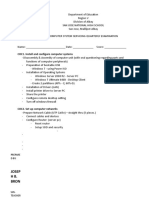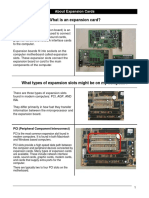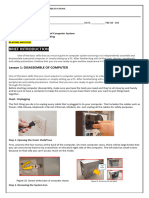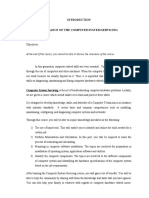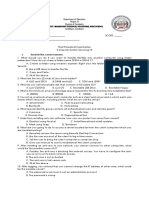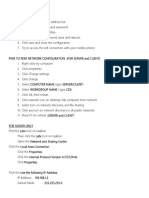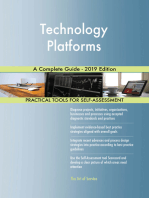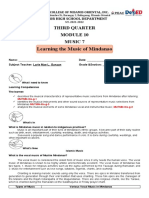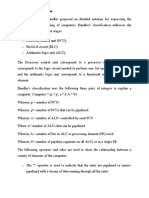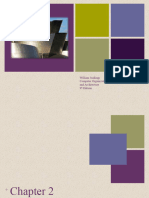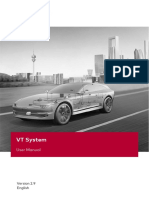0 ratings0% found this document useful (0 votes)
88 viewsHandout
Handout
Uploaded by
Joan VecillaAs an aspiring computer technician, it is important to understand the key hardware components of a computer system, which include the system unit containing the motherboard, CPU, memory, expansion slots and cards, power supply, hard disk drive, and optical drive. Input devices like keyboards and mice allow the user to enter data, while output devices such as printers and speakers allow the computer to display or communicate results. Ports and cables connect these internal and external components.
Copyright:
© All Rights Reserved
Available Formats
Download as DOCX, PDF, TXT or read online from Scribd
Handout
Handout
Uploaded by
Joan Vecilla0 ratings0% found this document useful (0 votes)
88 views1 pageAs an aspiring computer technician, it is important to understand the key hardware components of a computer system, which include the system unit containing the motherboard, CPU, memory, expansion slots and cards, power supply, hard disk drive, and optical drive. Input devices like keyboards and mice allow the user to enter data, while output devices such as printers and speakers allow the computer to display or communicate results. Ports and cables connect these internal and external components.
Original Title
handout
Copyright
© © All Rights Reserved
Available Formats
DOCX, PDF, TXT or read online from Scribd
Share this document
Did you find this document useful?
Is this content inappropriate?
As an aspiring computer technician, it is important to understand the key hardware components of a computer system, which include the system unit containing the motherboard, CPU, memory, expansion slots and cards, power supply, hard disk drive, and optical drive. Input devices like keyboards and mice allow the user to enter data, while output devices such as printers and speakers allow the computer to display or communicate results. Ports and cables connect these internal and external components.
Copyright:
© All Rights Reserved
Available Formats
Download as DOCX, PDF, TXT or read online from Scribd
Download as docx, pdf, or txt
0 ratings0% found this document useful (0 votes)
88 views1 pageHandout
Handout
Uploaded by
Joan VecillaAs an aspiring computer technician, it is important to understand the key hardware components of a computer system, which include the system unit containing the motherboard, CPU, memory, expansion slots and cards, power supply, hard disk drive, and optical drive. Input devices like keyboards and mice allow the user to enter data, while output devices such as printers and speakers allow the computer to display or communicate results. Ports and cables connect these internal and external components.
Copyright:
© All Rights Reserved
Available Formats
Download as DOCX, PDF, TXT or read online from Scribd
Download as docx, pdf, or txt
You are on page 1of 1
As an aspiring computer technician, it is very important to know the different components of a computer system.
These are the
hardware, software and peopleware. Each component plays an important role, without each other computer systems will not work
properly.
1.1 Hardware- the physical, touchable, electronic and mechanical parts of a computer system.
A. Major hardware components of a computer system
The following list represents a basic set of hardware found in most PCs.
1. System Unit- The main part of a microcomputer, sometimes called the chassis. It includes the following parts:
Motherboard, Microprocessor, Memory Chips, Buses, Ports, Expansion Slots and Cards.
2. 2. Motherboard / Mainboard / System Board- The main circuit board of a computer. It contains all the circuits and
components that run the computer.
3. 3. CPU (Central Processing Unit) - The processor is the main “brain” or “heart” of a computer system. It performs all of the
instructions and calculations that are needed and manages the flow of information through a computer.
4. 4. Primary storage- (internal storage, main memory or memory) is the computer's working storage space that holds data,
instructions for processing and processed data (information) waiting to be sent to secondary storage. Physically, primary
storage is a collection of RAM chips.
Two (2) Types of Memory
a. ROM – (Read Only Memory) ROM is non-volatile, meaning it holds data even when the power is ON or OFF.
b. RAM – (Random Access Memory) RAM is volatile, meaning it holds data only when the power is on. When the power is
off, RAM's contents are lost.
5. 5. Expansion Bus - A bus is a data pathway between several hardware components inside or outside a computer. It does
not only connect the parts of the CPU to each other, but also links the CPU with other important hardware.
6. Adapters- Printed-circuit boards (also called interface cards) that enable the computer to use a peripheral device for which
it does not have the necessary connections or circuit boards. They are often used to permit upgrading to a new different
hardware.
7. Power Supply Unit (PSU) - Installed in the back corner of the PC case, next to the motherboard. It converts 120vac
(standard house power) into DC voltages that are used by other components in the PC.
8. Hard Disk Drive (HDD) - Also known as hard drive, is a magnetic storage device that is installed inside the computer. The
hard drive is used as permanent storage for data. In a Windows computer, the hard drive is usually configured as the C:
drive and contains the operating system and applications.
9. Optical Drive- An optical drive is a storage device that uses lasers to read data on the optical media. There are three types
of optical drives: Compact Disc (CD), Digital Versatile Disc (DVD) and Blu-ray Disc (BD).
B. Input Devices - Accepts data and instructions from the user or from another computer system.
Two (2) Types of Input Devices
1.Keyboard Entry – Data is inputted to the computer through a keyboard.
Keyboard - The first input device developed for the PC.
2.Direct Entry – A form of input that does not require data to be keyed by someone sitting at a keyboard. Direct-entry devices create
machine-readable data on paper, or magnetic media, or feed it directly into the computer’s CPU.
Pointing Devices - An input device used to move the pointer (cursor) on screen.
Mouse - The most common 'pointing device' used in PCs. Every mouse has two
buttons and most have one or two scroll wheels.
C. Output Devices - Any piece of computer hardware that displays results after the computer has processed the input data that has
been entered.
Printer - A device that prints text or illustrations on paper.
LCD Projectors- utilize two sheets of polarizing material with a liquid crystal solution between them.
Speakers - Used to play sound.
D. Ports - External connecting sockets on the outside of the computer. This is a pathway into and out of the
computer. A port lets users plug in outside peripherals, such as monitors, scanners and printers.
E. Cables and Wires- A cable is most often two or more wires running side by side and bonded, twisted or braided
together to form a single assembly, but can also refer to a heavy strong rope.
You might also like
- O&k Fault CodesDocument2 pagesO&k Fault CodesAlejandro EspinozaNo ratings yet
- Chapter 6: Input and Output: Extending Capabilities of Computers and Mobile DevicesDocument5 pagesChapter 6: Input and Output: Extending Capabilities of Computers and Mobile DevicesKim Jo OmolidaNo ratings yet
- Quiz On Computer History and HardwareDocument4 pagesQuiz On Computer History and Hardwaremanunera1986No ratings yet
- Computer System Servicing: Quarter 1 - Module 2Document36 pagesComputer System Servicing: Quarter 1 - Module 2Sitti Sahara CabangcalanNo ratings yet
- CSS Quarterly Exam 1Document18 pagesCSS Quarterly Exam 1seph bronNo ratings yet
- Install Your PeripheralsDocument21 pagesInstall Your Peripheralsrichard vergaraNo ratings yet
- Introduction To Computing Chapter 4 TopicDocument12 pagesIntroduction To Computing Chapter 4 TopicCarl LarutaNo ratings yet
- ICT Parts of ComputerDocument7 pagesICT Parts of ComputerOzone DamsNo ratings yet
- Basic Parts of Computer 3Document5 pagesBasic Parts of Computer 3Alex PinedaNo ratings yet
- CSS II - Course Syllabus (Detailed)Document15 pagesCSS II - Course Syllabus (Detailed)Jsmjc IDNo ratings yet
- Inside Parts of A System UnitDocument2 pagesInside Parts of A System Unit谭娜No ratings yet
- Preparing Hand Tools in AnimationDocument9 pagesPreparing Hand Tools in AnimationRobert kite ClementeNo ratings yet
- Parts of The Motherboard - ProProfs QuizDocument12 pagesParts of The Motherboard - ProProfs QuizownlinkscribdNo ratings yet
- Basic Computer Skills TestDocument3 pagesBasic Computer Skills TestLeo Loven LumacangNo ratings yet
- Types and Parts of ComputerDocument3 pagesTypes and Parts of ComputerMARY JOY VILLARUEL100% (1)
- CSS - 05-Week 10 - Module 10 - What Is Command Prompt or CMDDocument4 pagesCSS - 05-Week 10 - Module 10 - What Is Command Prompt or CMDElixa HernandezNo ratings yet
- Unit Unit: Installation and Configuration of Operating SystemDocument52 pagesUnit Unit: Installation and Configuration of Operating SystemH123 Thawal GauravNo ratings yet
- Prepare UBS Bootable InstallerDocument5 pagesPrepare UBS Bootable InstallerronaldNo ratings yet
- 5-Computer Basics Buttons and Ports On A ComputerDocument29 pages5-Computer Basics Buttons and Ports On A ComputerKapinpilan Endaila Silongan CesNo ratings yet
- Reviewer PDFDocument30 pagesReviewer PDFLeary John Herza TambagahanNo ratings yet
- What Is A Computer?Document7 pagesWhat Is A Computer?Stevenson CacNo ratings yet
- The Turbo C EnvironmentDocument23 pagesThe Turbo C EnvironmentJirou ShibaNo ratings yet
- About Expansion CardsDocument3 pagesAbout Expansion CardsEmin Kültürel0% (1)
- G7-WORKSHEET-ICT-week-3 - NEWDocument4 pagesG7-WORKSHEET-ICT-week-3 - NEWEbb Lian AninoNo ratings yet
- TVL Ict Computer Systems Servicing Ncii q1 Module 4 Passed 1Document21 pagesTVL Ict Computer Systems Servicing Ncii q1 Module 4 Passed 1Leo LugaNo ratings yet
- Activity Sheet 5.1 - Disassemble Computer SystemDocument2 pagesActivity Sheet 5.1 - Disassemble Computer SystemLyssa BasNo ratings yet
- Chapter 1-Introduction To Web TechnologiesDocument11 pagesChapter 1-Introduction To Web TechnologiesadiNo ratings yet
- Computer Hardware ServicingDocument6 pagesComputer Hardware ServicingRy Cacatian KakuNo ratings yet
- PC Disassemble: Garrie V. Dela GraciaDocument13 pagesPC Disassemble: Garrie V. Dela GraciaJai AidamusNo ratings yet
- 01 Information Processing Cycle 1201113124804673 3Document16 pages01 Information Processing Cycle 1201113124804673 3Naseem Ahmed AbbasiNo ratings yet
- Girma Ict AssignmentDocument5 pagesGirma Ict AssignmentGemechuNo ratings yet
- Quarter 1 CSS 12 ExaminationDocument11 pagesQuarter 1 CSS 12 ExaminationPierre Vincent PorrasNo ratings yet
- Learning Activity Sheet In: Computer Systems ServicingDocument12 pagesLearning Activity Sheet In: Computer Systems ServicingCarvalds 0315No ratings yet
- Computer Networking: Ans. ModemDocument2 pagesComputer Networking: Ans. ModemGourav VaidhyaNo ratings yet
- A. Preliminary Activity:: Integration With English LiteracyDocument6 pagesA. Preliminary Activity:: Integration With English LiteracyLima AlphaNo ratings yet
- Module 1Document43 pagesModule 1Jason EchevariaNo ratings yet
- System Unit Activity 2Document3 pagesSystem Unit Activity 2Keziah AliwanagNo ratings yet
- BIOS or Basic Input Output SystemDocument5 pagesBIOS or Basic Input Output SystemIssan VillaruelNo ratings yet
- How To Assemble and Disassemble A Computer IT Assingment 1Document15 pagesHow To Assemble and Disassemble A Computer IT Assingment 1HARSHITA AKANKSHANo ratings yet
- Basic Competency QuizesDocument16 pagesBasic Competency QuizesEric Manrique TalamisanNo ratings yet
- CssDocument9 pagesCssSheng Suelto CarpenteroNo ratings yet
- Basic-Configuration-and-Installation-of-Operating-System FinalDocument43 pagesBasic-Configuration-and-Installation-of-Operating-System FinalLevi CorralNo ratings yet
- Intro To NetworkingDocument29 pagesIntro To NetworkingQueniel QuezmarNo ratings yet
- 3rd Grading ExamDocument4 pages3rd Grading ExamJhunel Ceazar A. AlejoNo ratings yet
- 02-Understanding The Programming ProcessDocument34 pages02-Understanding The Programming ProcessLilian May MalfartaNo ratings yet
- Lesson 8: Installingand Configuring Computer SystemsDocument90 pagesLesson 8: Installingand Configuring Computer SystemsGordon BenitezNo ratings yet
- Server Config NotesDocument5 pagesServer Config NotesJovan Christian OlanNo ratings yet
- CSSNC II Assessment ModuleDocument7 pagesCSSNC II Assessment ModuleMardy Mararac100% (1)
- Css8 q1w3 10pgs Franco SptveDocument12 pagesCss8 q1w3 10pgs Franco SptveGREGORIO QUINERINo ratings yet
- CSS NC II Questioner For CheatersDocument11 pagesCSS NC II Questioner For CheatersEuropez Alaskha67% (3)
- Ports and Connections - 120738Document22 pagesPorts and Connections - 120738Beatrice DacilloNo ratings yet
- CSS Installing Computer SystemDocument58 pagesCSS Installing Computer SystemMelody Gamosa TaralaNo ratings yet
- Student Handout 1 Hardware Components of A ComputerDocument4 pagesStudent Handout 1 Hardware Components of A ComputerLemuel Condes100% (1)
- CSS Ncii PPT 03Document62 pagesCSS Ncii PPT 03Dave Ruiz100% (1)
- The Component of System UnitDocument52 pagesThe Component of System UnitgtNo ratings yet
- The Common Network DevicesDocument14 pagesThe Common Network DevicesNylevonNo ratings yet
- Computer Week 1Document13 pagesComputer Week 1Jan Paulo SantosNo ratings yet
- Info Sheet Lesson 1Document3 pagesInfo Sheet Lesson 1Theresa Genaro BustillosNo ratings yet
- Grade8 - Q1-4 - W2 PCO Part 1.pdf 1Document8 pagesGrade8 - Q1-4 - W2 PCO Part 1.pdf 1Lynnel yapNo ratings yet
- What's In: St. Peter'S College of Misamis Oriental, IncDocument14 pagesWhat's In: St. Peter'S College of Misamis Oriental, IncJoan VecillaNo ratings yet
- Department of Education: Baliwagan National High SchoolDocument2 pagesDepartment of Education: Baliwagan National High SchoolJoan VecillaNo ratings yet
- Elements of LeadershipDocument16 pagesElements of LeadershipJoan VecillaNo ratings yet
- Learning The Music of MindanaoDocument4 pagesLearning The Music of MindanaoJoan VecillaNo ratings yet
- Learning More About Personal and Mental HealthDocument4 pagesLearning More About Personal and Mental HealthJoan VecillaNo ratings yet
- Junior High School Department: Learning Module 10 Mathematics 7Document17 pagesJunior High School Department: Learning Module 10 Mathematics 7Joan VecillaNo ratings yet
- Module 1 Answers - Soc ArtsDocument3 pagesModule 1 Answers - Soc ArtsJoan VecillaNo ratings yet
- Math in Modern World, A SynthesisDocument1 pageMath in Modern World, A SynthesisJoan VecillaNo ratings yet
- Introducing The Arts and Crafts of Mindanao: Third QuarterDocument4 pagesIntroducing The Arts and Crafts of Mindanao: Third QuarterJoan VecillaNo ratings yet
- Misamis Oriental Institute of Science and TechnologyDocument2 pagesMisamis Oriental Institute of Science and TechnologyJoan VecillaNo ratings yet
- TLE7-8 Learning EssentialsDocument27 pagesTLE7-8 Learning EssentialsJoan Vecilla100% (2)
- Misamis Oriental Institute of Science and TechnologyDocument2 pagesMisamis Oriental Institute of Science and TechnologyJoan Vecilla0% (1)
- MODULE-1 Contemp World - Marven LlonaDocument4 pagesMODULE-1 Contemp World - Marven LlonaJoan VecillaNo ratings yet
- PatternDocument1 pagePatternJoan VecillaNo ratings yet
- Baliwagan National High School: Grade 7 Answer SheetDocument1 pageBaliwagan National High School: Grade 7 Answer SheetJoan Vecilla100% (1)
- Matrix of Curriculum Standards (Competencies), With Corresponding Recommended Flexible Learning Delivery Mode and Materials Per Grading PeriodDocument3 pagesMatrix of Curriculum Standards (Competencies), With Corresponding Recommended Flexible Learning Delivery Mode and Materials Per Grading PeriodJoan VecillaNo ratings yet
- Baliwagan National High School: Music 8 Answer SheetDocument2 pagesBaliwagan National High School: Music 8 Answer SheetJoan VecillaNo ratings yet
- Matrix of Curriculum Standards (Competencies), With Corresponding Recommended Flexible Learning Delivery Mode and Materials Per Grading PeriodDocument4 pagesMatrix of Curriculum Standards (Competencies), With Corresponding Recommended Flexible Learning Delivery Mode and Materials Per Grading PeriodJoan VecillaNo ratings yet
- Baliwagan National High School: Grade 7 Answer SheetDocument1 pageBaliwagan National High School: Grade 7 Answer SheetJoan Vecilla100% (1)
- Matrix of Curriculum Standards (Competencies), With Corresponding Recommended Flexible Learning Delivery Mode and Materials Per Grading PeriodDocument2 pagesMatrix of Curriculum Standards (Competencies), With Corresponding Recommended Flexible Learning Delivery Mode and Materials Per Grading PeriodJoan VecillaNo ratings yet
- Curriculum Implementation and Learning Matrix English G7 - BERIGAY - DADANGDocument10 pagesCurriculum Implementation and Learning Matrix English G7 - BERIGAY - DADANGJoan VecillaNo ratings yet
- DEDICATION and ACKNOWLEDGEMENTDocument5 pagesDEDICATION and ACKNOWLEDGEMENTJoan VecillaNo ratings yet
- Cinderella Ashley Kate L. VecillaDocument1 pageCinderella Ashley Kate L. VecillaJoan VecillaNo ratings yet
- Matrix of Curriculum Standards (Competencies), With Corresponding Recommended Flexible Learning Delivery Mode and Materials Per Grading PeriodDocument3 pagesMatrix of Curriculum Standards (Competencies), With Corresponding Recommended Flexible Learning Delivery Mode and Materials Per Grading PeriodJoan VecillaNo ratings yet
- Department of Education: X Misamis Oriental Baliwagan National High School Baliwagan, Balingasagmis. orDocument1 pageDepartment of Education: X Misamis Oriental Baliwagan National High School Baliwagan, Balingasagmis. orJoan VecillaNo ratings yet
- Parental Consent: Rosario National High SchoolDocument6 pagesParental Consent: Rosario National High SchoolJoan VecillaNo ratings yet
- Matrix of Curriculum Standards (Competencies), With Corresponding Recommended Flexible Learning Delivery Mode and Materials Per Grading PeriodDocument2 pagesMatrix of Curriculum Standards (Competencies), With Corresponding Recommended Flexible Learning Delivery Mode and Materials Per Grading PeriodJoan VecillaNo ratings yet
- Department of Education: List of Not Mastered Learning CompetenciesDocument3 pagesDepartment of Education: List of Not Mastered Learning CompetenciesJoan VecillaNo ratings yet
- TIFF (Also Known As TIF), File Types Ending in .TifDocument1 pageTIFF (Also Known As TIF), File Types Ending in .TifJoan VecillaNo ratings yet
- LEARNING PLAN - Summer ClassDocument1 pageLEARNING PLAN - Summer ClassJoan VecillaNo ratings yet
- RosemorDocument18 pagesRosemorAlejandro BermedoNo ratings yet
- 02 Embedded Design Life CycleDocument19 pages02 Embedded Design Life CyclePAUL SATHIYANNo ratings yet
- Certificate Rail System ABS RailTraxDocument3 pagesCertificate Rail System ABS RailTraxMamelucoNo ratings yet
- Components 103 203 PumpDocument60 pagesComponents 103 203 PumpChristopher BessinasNo ratings yet
- Densitypro: Gamma Density SystemDocument87 pagesDensitypro: Gamma Density SystemTrần Danh VũNo ratings yet
- Handler's ClassificationDocument3 pagesHandler's ClassificationHarsh100% (1)
- CH02 COA9eDocument61 pagesCH02 COA9eArif KamalNo ratings yet
- CQT Troubleshoooting V1.0Document10 pagesCQT Troubleshoooting V1.0KhangTranNo ratings yet
- Sony Svs151290X-SVS151C1GL MarketingSpecifications610238.2063353615Document2 pagesSony Svs151290X-SVS151C1GL MarketingSpecifications610238.2063353615ShantalaNo ratings yet
- s71500 Di 32x24vdc Ba Manual en-US en-USDocument36 pagess71500 Di 32x24vdc Ba Manual en-US en-USPhan Hữu TàiNo ratings yet
- VT System Manual enDocument239 pagesVT System Manual enPriyankNo ratings yet
- 1.1 5 Storage I O Device PDFDocument14 pages1.1 5 Storage I O Device PDFJohn Chris VillanuevaNo ratings yet
- NetBackup 5340 Appliance Product DescriptionDocument87 pagesNetBackup 5340 Appliance Product Descriptionjarg200690No ratings yet
- Xenia-Canary-Netplay Config TomlDocument14 pagesXenia-Canary-Netplay Config TomlAlison LimaNo ratings yet
- 7685 21597 1 PBDocument12 pages7685 21597 1 PBmila SariNo ratings yet
- AC 43.13-1B-Hardware Identification Table-3d-Ch7 - 11Document26 pagesAC 43.13-1B-Hardware Identification Table-3d-Ch7 - 11MASOUDNo ratings yet
- FPGA Roadmap - 2019Document36 pagesFPGA Roadmap - 2019freeddawgmcNo ratings yet
- Dell OptiPlex 7060 Micro Setup and Specifications GuideDocument38 pagesDell OptiPlex 7060 Micro Setup and Specifications GuidederelayNo ratings yet
- 2023-24 Lab Manual EE2314 Embedded Systems PTKDocument26 pages2023-24 Lab Manual EE2314 Embedded Systems PTKRahul KamdiNo ratings yet
- Operating System Summary of Chapter 5Document10 pagesOperating System Summary of Chapter 5mohamedabdulkadir767No ratings yet
- 3DHouse ReportDocument30 pages3DHouse ReportSimraaNo ratings yet
- P3P4FightingBoard UserGuide 20180620V1Document3 pagesP3P4FightingBoard UserGuide 20180620V1Edy ArquemanNo ratings yet
- Top Tu131 MB NPB Ver DDocument63 pagesTop Tu131 MB NPB Ver DRENATO PESSOANo ratings yet
- Gigabyte G292-2G0 User ManualDocument113 pagesGigabyte G292-2G0 User ManualddscribeNo ratings yet
- Como Hacer Un Cable VGA A RCB Video ComponentesDocument10 pagesComo Hacer Un Cable VGA A RCB Video ComponentesJavier UchaNo ratings yet
- 7705-K055Document73 pages7705-K055atmrmg03No ratings yet
- Lesson 02 - Main Parts of ComputerDocument22 pagesLesson 02 - Main Parts of ComputerDummy AccountNo ratings yet
- A590 Hard Drive Plus User GuideDocument68 pagesA590 Hard Drive Plus User Guidedinis.carrico6240No ratings yet
- ECSE Important 5 Mark QuestionsDocument12 pagesECSE Important 5 Mark Questionskvsouravsohil2005No ratings yet




